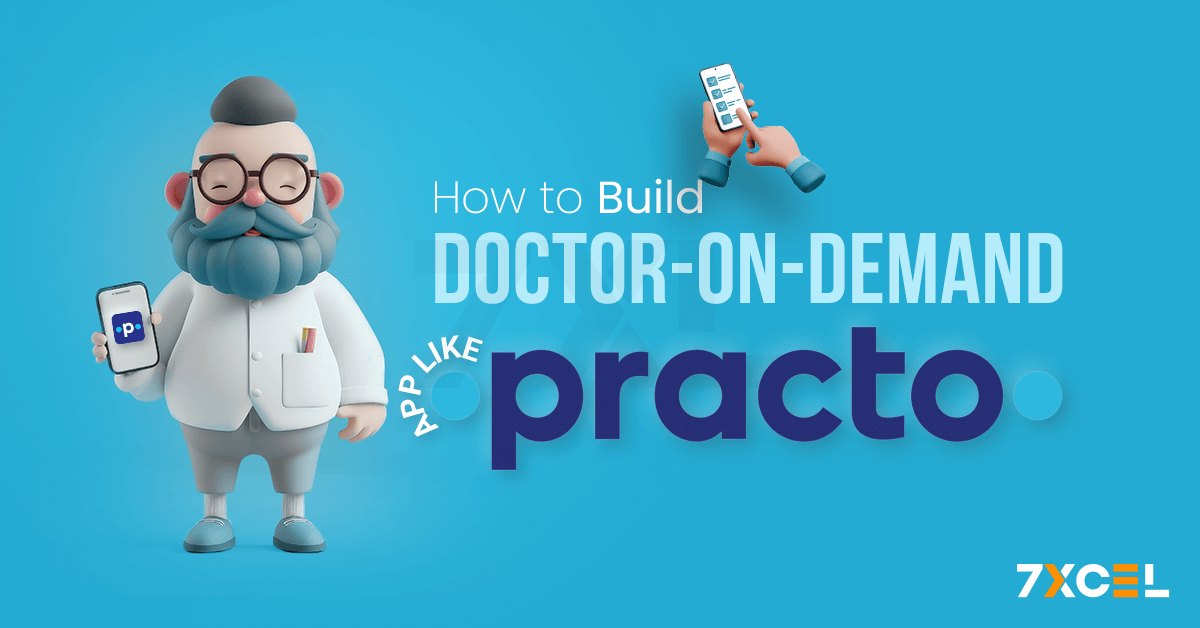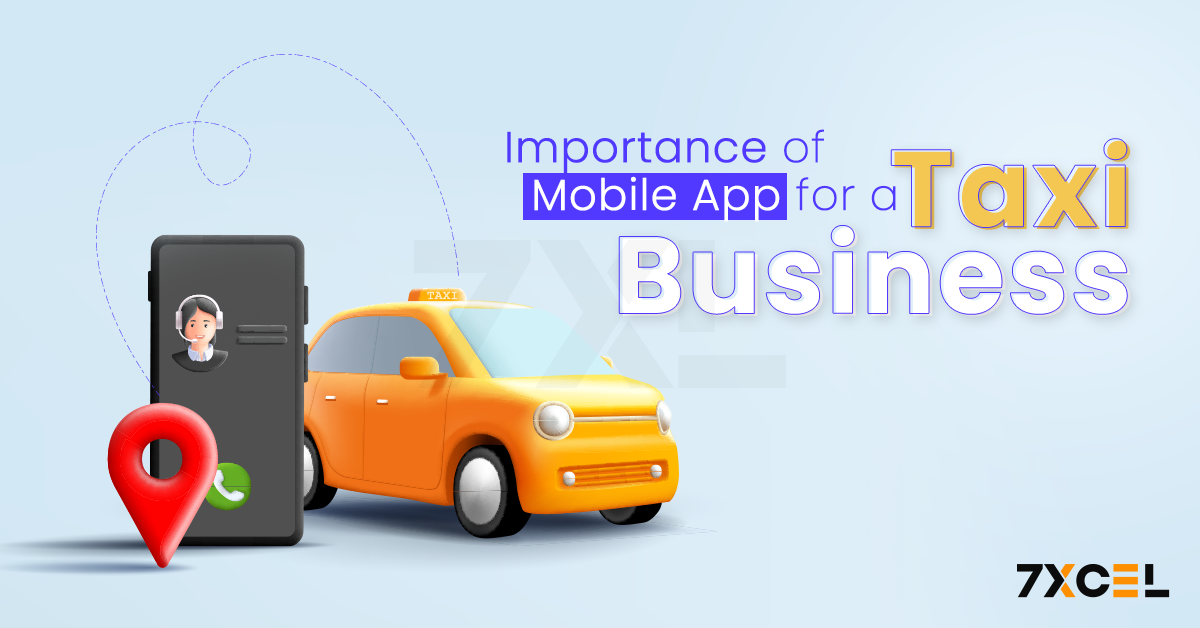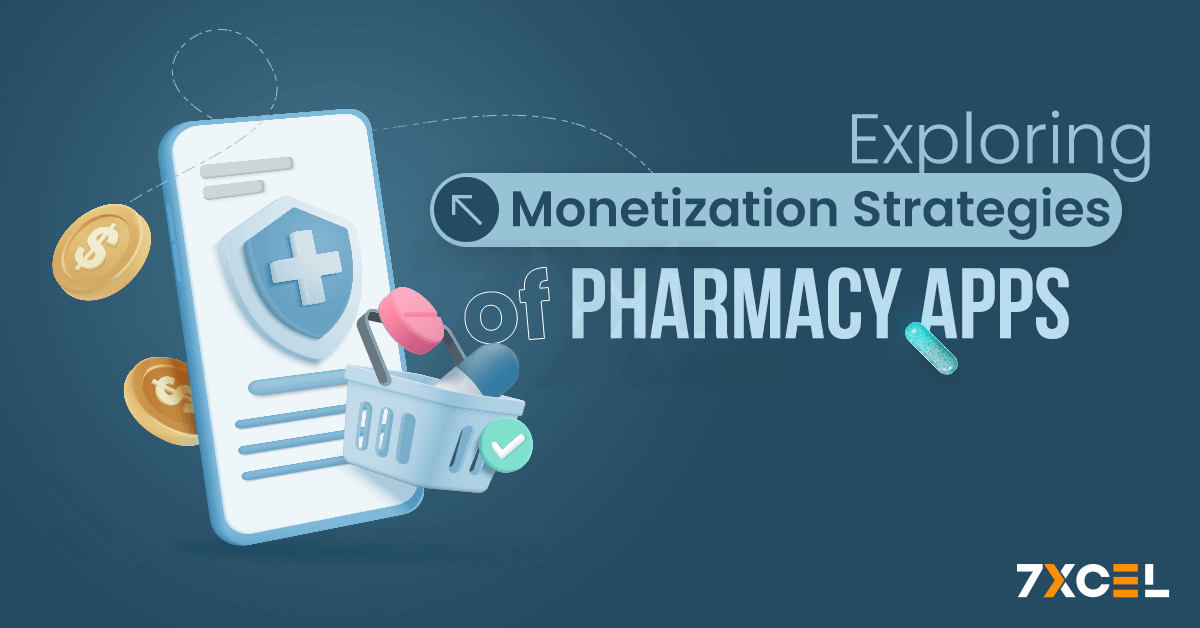Quick Summary:
Building a doctor on-demand app like Practo requires understanding market needs, defining core features, selecting the right technology stack, ensuring security & compliance, & effective marketing. Partnering with an experienced IT service provider can help you create a successful telemedicine platform.
In this blog, we’re going to discuss📝
- Understanding the Market
- Essential Features of a Doctor on Demand App
- Choosing the Right Technology Stack
- Designing an Intuitive User Interface
- Developing the Doctor-on-Demand App
- Launching the Doctor-on-Demand App
- Monetization Strategies for Doctor-on-Demand App
- Ensuring Security and Compliance
- Scaling and Future Enhancements
The healthcare industry has transformed significantly with the rise of doctor on demand apps, revolutionizing access to convenient and immediate healthcare. The increasing use of telehealth solutions and remote patient monitoring is expected to propel the global telemedicine industry, which is expected to reach $298.9 billion by 2028, rising at a annual rate of 22.4% from 2021 to 2028.
Apps like Practo play a vital role by providing timely medical consultations, easing the burden on physical clinics, and enhancing the overall healthcare experience. This blog will guide you through the important steps, features, and considerations for building a successful doctor on demand app.
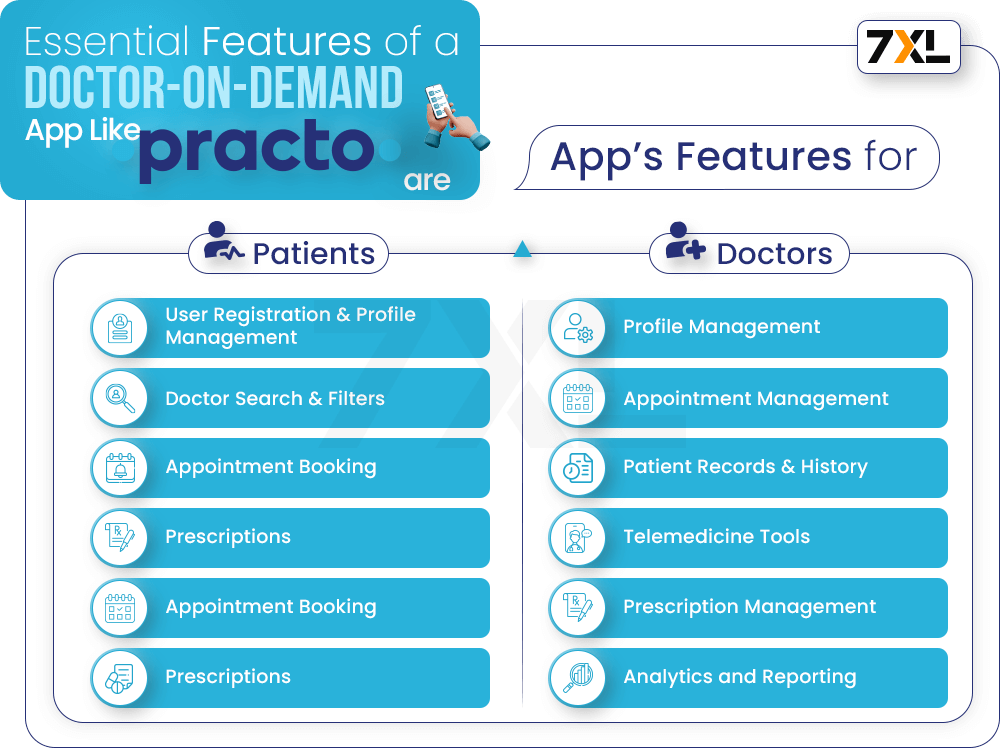
1. Understanding the Market
Before embarking on the journey of building a doctor on demand app, it’s crucial to understand the market landscape. The healthcare industry is vast and diverse, with various stakeholders including patients, doctors, hospitals, and insurance companies.
Market Research and Analysis
Conduct in-depth market research to identify the needs & preferences of your target audience. Analyze existing competitors like Practo, Zocdoc, and Teladoc to understand their strengths and weaknesses. Consider the following aspects:
- Target Audience: Identify your primary users. Are they patients seeking general consultations, specialized treatments, or mental health support?
- Geographic Focus: Determine the regions you want to serve. Healthcare regulations and requirements vary across countries.
- Regulatory Compliance: Recognize what laws and regulations, such as GDPR in Europe and HIPAA in the US, apply in your target regions.
2. Essential Features of a Doctor on Demand App
Numerous features that address the needs of healthcare practitioners and patients alike should be included in a successful doctor-on-demand app. Here are the essential features to consider:
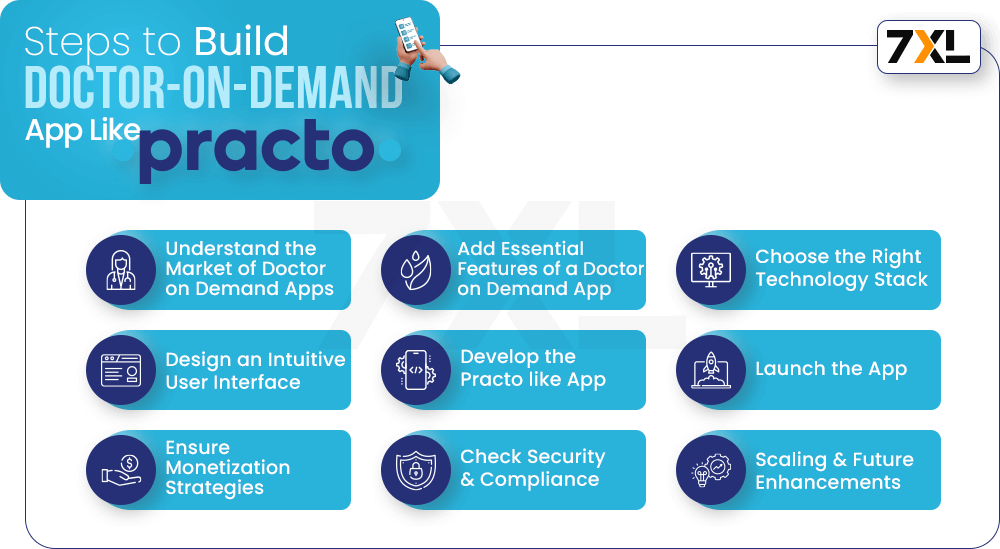
For Patients
- User Registration and Profile Management: Permit users to edit their profiles, adding and removing personal, health, and insurance information as needed.
- Doctor Search and Filters: Enable patients to search for doctors based on specialty, location, ratings, and availability.
- Appointment Booking: Provide an easy to use interface for booking, rescheduling, and cancelling appointments.
- Telemedicine and Video Consultations: Integrate secure video conferencing for remote consultations.
- Prescriptions: Allow doctors to send electronic prescriptions directly to patients.
- In-App Payments: Support multiple payment methods for seamless transactions.
- Ratings and Reviews: Enable patients to rate and review doctors to help others make informed decisions.
For Doctors
- Profile Management: Allow doctors to manage their profiles, including qualifications, specialties, and availability.
- Appointment Management: Provide tools for managing appointments, including notifications and reminders.
- Patient Records and History: Enable access to patient records and medical history for informed consultations.
- Telemedicine Tools: Integrate tools for conducting video consultations, including chat and file sharing.
- Prescription Management: Allow doctors to create and send electronic prescriptions.
- Analytics and Reporting: Offer insights and reports on consultations, patient feedback, and earnings.
3. Choosing the Right Technology Stack
Choosing the right technology stack is critical for the performance, scalability, and security of your doctor-on-demand app. Partnering with a specialized Doctor-On-Demand App Development Company can ensure that these key components are selected and implemented effectively.
Their expertise in healthcare technology helps in building a platform that meets regulatory standards, supports real-time communication, and ensures data security. Here are the key components to consider:
Frontend Development
- Frameworks and Libraries: React Native or Flutter for cross-platform mobile app development.
- UI/UX Design: Focus on developing an instinctive & user friendly interface.
Backend Development
- Programming Languages : Node.js, Python (Django), or Ruby on Rails.
- Database: MySQL, PostgreSQL, or MongoDB for storing user data and medical records.
- APIs: Integrate third party APIs for functionalities like video conferencing (e.g., Twilio), payment processing (e.g., Stripe), and geolocation services.
Security
- Data Encryption: Ensure all data transmissions are encrypted to protect sensitive information.
- Authentication and Authorization: Implement multi-factor authentication and role based access control.
- Compliance: Ensure compliance with healthcare regulations like HIPAA and GDPR.
4. Designing an Intuitive User Interface
An on-demand medical app’s success heavily relies on its user interface (UI) and user experience (UX). A well designed app ensures that users can easily navigate and utilize its features.
Key Design Principles
- Simplicity: Keep the design clean and straightforward, minimizing the steps required to book an appointment or access information.
- Consistency: Maintain a consistent design language across the app, including colors, fonts, and button styles.
- Accessibility: Incorporate tools such as screen readers and voice commands to make sure the software is usable by people with impairments.
- Responsiveness: Create a responsive app that works seamlessly on a variety of screens and devices.
Wire framing and Prototyping
Start with wireframes to outline the app’s structure and layout. Create interactive prototypes with the aid of prototyping tools such as Figma or Adobe XD, then solicit input from stakeholders and future consumers.
5. Developing the Doctor-on-Demand App
Once you have a clear understanding of the market, essential features, technology stack, and design, it’s time to start the development process.
Agile Development Methodology
To ensure flexibility, use an agile development methodology and iterative progress. Break down the development process into sprints, each focusing on specific features or components.
Backend Development
- Database Setup: Configure the database to store user profiles, medical records, appointments, and other relevant data.
- API Development: Develop RESTful APIs to handle data exchange between the frontend and backend.
- Security Implementation: Integrate security measures like data encryption, secure authentication, and access control.
Frontend Development
- UI Implementation: Develop the user interface based on the designed prototypes, ensuring responsiveness and accessibility.
- Integration with Backend: Connect the frontend with the backend APIs to enable functionalities like user registration, appointment booking, and telemedicine.
Testing and Quality Assurance
The in-depth testing is vital to identify & fix bugs, ensure security, and validate the app’s performance. Conduct various types of testing, including:
- Unit Testing: Test individual components and functions.
- Integration Testing: Ensure that number of different parts of the app work together seamlessly.
- User Acceptance Testing (UAT): Involve real users in testing the app to gather feedback and identify usability issues.
- Security Testing: Conduct security audits to identify vulnerabilities and ensure compliance with regulations.
6. Launching the Doctor-on-Demand App
Once the development and testing phases are complete, it’s time to launch the app. A successful launch involves careful planning and execution.
Pre-launch Preparations
- Beta Testing: Conduct a beta test with a small group of users to gather feedback and make final adjustments.
- Marketing & Promotion: Create a marketing strategy to create awareness and attract users. Use social media, email marketing, and partnerships with healthcare providers to promote the app.
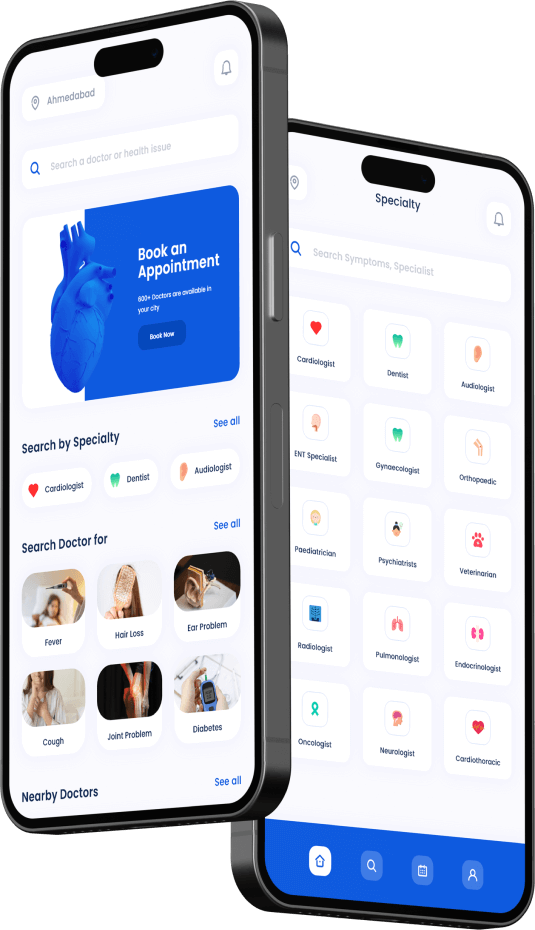
Interested to develop a standout Doctor-on-Demand App?
Build your cutting-edge doctor app with 7xcel – quicker, simpler, and packed with features that enhance patient care.
App Store Submission
Upload the software to the appropriate app stores (software Store for Apple, Play Store for Google). Ensure compliance with their guidelines and prepare all necessary documentation, including app descriptions, screenshots, and privacy policies.
Post Launch Activities
- Monitor Performance: Continuously monitor the app’s performance & user feedback to identify & address any issues.
- Regular Updates: Release regular updates to introduce new features, fix bugs, and improve performance.
- Customer Support: Provide prompt & effective customer support to address user queries and concerns.
7. Monetization Strategies for Doctor-on-Demand App
To ensure the sustainability and profitability of your doctor on demand app, consider various monetization strategies:
Subscription Model
Offer subscription plans with different levels of access and features. For example, a basic plan could include limited consultations, while a premium plan offers unlimited access to top specialists.
Pay Per Consultation
Charge users on a per consultation basis, allowing them to pay for each appointment individually. Users who prefer this model may find it appealing who are not interested to commit to a subscription.
Advertising
Partner with healthcare brands, pharmacies, and medical equipment providers to display relevant ads within the app. Ensure that the ads are non intrusive and add value to the user experience.
Partnerships and Collaborations
Collaborate with healthcare providers, insurance companies, and pharmaceutical companies to offer integrated services. For example, partner with pharmacies to provide prescription delivery services.
8. Ensuring Security and Compliance
In the healthcare sector, security and conformance are critical factors. To secure user data and maintain security, make sure your app complies with industry norms and regulations.
Data Encryption
Protect sensitive information from breaches and unwanted access by encrypting it while it’s in transit and at rest.
Authentication and Authorization
Implement robust authentication mechanisms, such as multi-factor authentication, to verify user identities. Use role based access control to restrict access to sensitive information based on user roles.
Regulatory Compliance
Make sure you are in compliance with all applicable healthcare laws, including GDPR in Europe and HIPAA in the United States. This entails obtaining user consent before collecting data and offering procedures for accessing and deleting data.
Regular Security Audits
To find and stop possible threats, do frequent vulnerability assessments and security audits. Keep up with the most recent security best practices and put the appropriate safeguards in place to keep your app and its users safe.
9. Scaling and Future Enhancements
As your doctor on demand app gains traction, it’s important to plan for scaling and future enhancements to meet growing user demands and stay competitive.
Scalability
Ensure that your app’s architecture can handle increasing user traffic and data. Use scalable cloud infrastructure and load balancing techniques to maintain performance and reliability.
New Features
Continuously innovate and introduce new features to enhance the user experience. Consider adding functionalities like:
- AI-Powered Symptom Checker: Integrate AI to provide users with preliminary diagnoses based on their symptoms.
- Wearable Integration: Connect with wearable devices to monitor patients’ health metrics and provide real-time feedback.
- Mental Health Support: Expand your services to include mental health consultations and therapy sessions.
Global Expansion
Explore opportunities for global expansion by adapting your app to different languages, cultures, and healthcare regulations. Conduct market research to identify regions with high demand for telemedicine services and tailor your offerings accordingly.
Conclusion
Building a cost-efficient doctor on demand app like Practo requires careful planning, thorough research, and a commitment to delivering a high quality, secure, and user-friendly service. To create a successful healthcare app, it’s essential to understand the market, incorporate necessary features, choose the right technology, and ensure security and compliance. As telemedicine becomes a vital part of modern healthcare, developing a doctor-on-demand app can contribute to this transformation by providing reliable and user-friendly services globally. With a clear vision, you can create an impactful app that stands out in the competitive healthcare market.
